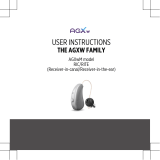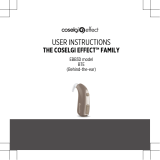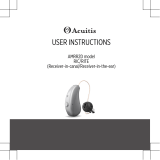
USER INSTRUCTIONS
THE WIDEX MOMENT™ FAMILY
MRR2D model
RIC/RITE
(Receiver-in-canal/Receiver-in-the-ear)

IMPORTANT SAFETY INFORMATION
Read these pages carefully before you begin using your hearing aid.
WARNING: People younger than 18 should go to a doctor before using
this. People younger than 18 years old need specialized care, and using
this without a medical evaluation may worsen impairment or disability.
A hearing aid user who is younger than 18 should have a recent medical
evaluation from a doctor, preferably an ear-nose-throat doctor (an ENT).
Before using this, a doctor should determine that the use of a hearing aid
is appropriate.
WARNING to Hearing Aid Dispensers:
You should advise a prospective hearing aid user to consult promptly
with a doctor, preferably an ear specialist such as an ENT, before dispens-
ing a hearing aid if you determine through inquiry, actual observation,
or review of any other available information concerning the prospective
user, that the prospective user has any of the following conditions:
- Visible deformity of the ear, either congenital or traumatic
- Fluid, pus, or blood coming out of the ear within the previous 6 months
- Pain or discomfort in the ear
- History of excessive ear wax or suspicion that something is in the ear
canal
- Dizziness, either recent or long-standing
- Sudden, quickly worsening, or fluctuating hearing loss within the previ-
ous 6 months
2

- Hearing loss or ringing (tinnitus) only in one ear or a noticeable
difference in hearing between ears
- Audiometric air-bone gap equal to or greater than 15 dB at 500 Hz,
1000 Hz, and 2000 Hz
WARNING to Hearing Aid Dispenser, Outputs over 132 dB SPL:You
should exercise special care in selecting and fitting a hearing aid with
a maximum output that exceeds 132 dB SPL because it may impair the
remaining hearing of the hearing aid user.
Keep hearing aids, their parts, accessories and batteries away from
children and mentally disabled people.
Hearing aids and batteries can be dangerous if swallowed or used
improperly. Swallowing or improper use can result in severe injury or
even fatalities. In case of ingestion, contact a doctor immediately and
the 24 Hour National Button Battery Ingestion Hotline at (202) 625
3333.
Take your hearing aids out when you are not using them. This will help to
ventilate the ear canal and prevent ear infections.
Contact your doctor or hearing care professional immediately if you
suspect you may have an ear infection or an allergic reaction.
Contact your hearing care professional if the hearing aid doesn't feel
comfortable, or if it doesn't fit properly, causing irritation, redness or the
like.
Remove your hearing aids before showering, swimming or using a hair
dryer.
3

Do not wear your hearing aids when applying perfume, spray, gel, lotion
or cream.
Do not dry your hearing aid in a microwave oven – this will ruin it.
Never use other people’s hearing aids and never allow others to use
yours, as this could damage your hearing.
Never use your hearing aids in environments where there may be explo-
sive gases, such as in mines.
Never try to open or repair the hearing aid yourself. Contact your hearing
care professional if you need to have your hearing aid repaired.
Your hearing aids contain radio communication technology. Always ob-
serve the environment in which you are using them. If any restrictions
apply, you must take precautions to comply with these.
Your device has been designed to comply with international electromag-
netic compatibility standards. However, there is still the possibility that it
may cause interference with other electrical equipment. If you experience
interference, keep a distance to other electrical equipment.
Please note that streaming sound to your hearing aids at a high volume
can prevent you from hearing other important sounds such as alarms
and traffic noise. In such situations make sure to keep the volume of the
streamed sound at a suitable level.
Do not expose your hearing aids to extreme temperatures or high humid-
ity, and dry them quickly if they get wet or if you perspire heavily.
Do not use any kind of liquid or disinfectant to clean your hearing aid.
4

Clean and inspect your hearing aid every day after use to check that it is
not broken. If the hearing aid is damaged while you are wearing it and
small fragments are left in your ear canal, seek medical attention. Never
try to take out the fragments yourself.
Caution: This is not hearing protection.
You should remove this device if you experience overly loud sounds,
whether short or long-lasting. If you're in a loud place, you should use the
right kind of hearing protection instead of wearing this device. In general,
if you would use ear plugs in a loud place, you should remove this device
and use ear plugs.
Caution: The sound output should not be uncomfortable or painful.
You should turn down the volume or remove the device if the sound
output is uncomfortably loud or painful. If you consistently need to turn
the volume down, you may need to further adjust your device.
Caution: You might need medical help if a piece gets stuck in your ear.
If any part of your hearing aid, like the eartip, gets stuck in your ear, and
you can't easily remove it with your fingers, get medical help as soon as
you can.
You should not try to use tweezers or cotton swabs because they can
push the part farther into your ear, injuring your eardrum or ear canal,
possibly seriously.
Note: What you might expect when you start using a hearing aid.
A hearing aid can benefit many people with hearing loss. However, you
should know it will not restore normal hearing, and you may still have
some difficulty hearing over noise. Further, a hearing aid will not prevent
or improve a medical condition that causes hearing loss.
5

People who start using hearing aids sometimes need a few weeks to get
used to them. Similarly, many people find that training or counseling can
help them get more out of their devices.
If you have hearing loss in both ears, you might get more out of using
hearing aids in both, especially in situations that make you tired from
listening-for example, noisy environments.
Note: Tell FDA about injuries, malfunctions, or other adverse events.
To report a problem involving your hearing aid, you should submit
information to FDA as soon as possible after the problem. FDA calls them
"adverse events," and they might include: skin irritation in your ear, injury
from the device (like cuts or scratches, or burns from an overheated bat-
tery), pieces of the device getting stuck in your ear, suddenly worsening
hearing loss from using the device, etc.
Instructions for reporting are available at https://www.fda.gov/Safety/
MedWatch, or call 1-800-FDA-1088. You can also download a form to
mail to FDA.
Note: Hearing loss in people younger than 18.
- People younger than 18 should see a doctor first, preferably an ear-
nose- throat doctor (an ENT), because they may have different needs
than adults.
- The doctor will identify and treat medical conditions as appropriate.
- The doctor may refer the person to an audiologist for a separate test, a
hearing aid evaluation.
- The hearing aid evaluation will help the audiologist select and fit the
appropriate hearing aid.
6

A person who is younger than 18 years old with hearing loss should have
a medical evaluation by a doctor, preferably an ENT, before buying a
hearing aid.
The purpose of a medical evaluation is to identify and treat medical
conditions that may affect hearing but that a hearing aid won't treat on its
own.
Following the medical evaluation and if appropriate, the doctor will
provide a written statement that the hearing loss has been medically
evaluated and the person is a candidate for a hearing aid. The doctor
may refer the person to an audiologist for a hearing aid evaluation, which
is different from the medical evaluation and is intended to identify the
appropriate hearing aid.
The audiologist will conduct a hearing aid evaluation to assess the per-
son's ability to hear with and without a hearing aid. This will enable
the audiologist to select and fit a hearing aid for the person's individual
needs. An audiologist can also provide evaluation and rehabilitation
since, for people younger than 18, hearing loss may cause problems in
language development and educational and social growth. An audiologist
is qualified by training and experience to assist in the evaluation and
rehabilitation of hearing loss in people younger than 18.
7

YOUR HEARING AID
(To be filled out by your hearing care professional)
This is a list of possible programs for your hearing aid.
For further information on the use of these programs, see Customization.
Your hearing aid programs:
PROGRAMS AUDIBILITY EXTENDER
Universal
PureSound
Quiet
Comfort
Transport
Urban
Impact
Party
Social
Music
8

SPECIAL PROGRAMS AUDIBILITY EXTENDER
Zen
Phone
SMARTTOGGLE PROGRAMS AUDIBILITY EXTENDER
Zen+
The program names in the table are the default names. If you have chosen
to use some of the other names available, write the new names in the table.
That way you will always know which programs you have in your hearing
aids.
Read the instructions
Carefully read the user instructions in this booklet and in the booklet
"Ear-sets for Widex hearing aids" before you start using your hearing aid.
You should also read the user instructions for the charger.
Sound streaming and wireless control
The hearing aid allows sound streaming and direct wireless control from
smartphones and other devices via DEX. For more help and information
contact your hearing care professional or visit: www.wsa.com.
The hearing aid works wirelessly with the MOMENT app. We take no
responsibility if the hearing aid is used with any third party app or if the app
is used with any other device. Read more about the app in the booklet.
9

CONTENTS
YOUR HEARING AID..................................................................................12
Welcome..........................................................................................................12
CONDITIONS FOR USE.............................................................................. 14
Indications for use..........................................................................................14
Intended use................................................................................................... 14
Charging.......................................................................................................... 15
Use time and charging time..........................................................................15
Operating and charging conditions..............................................................17
Storage and transport conditions.................................................................18
DAILY USE............................................................................................... 20
Turning the hearing aid on and off............................................................. 20
Putting on and removing the hearing aid...................................................21
CUSTOMIZATION......................................................................................22
Programs........................................................................................................ 22
Sound signals................................................................................................. 27
Sound and program adjustment................................................................. 29
Using a smartphone with your hearing aid.................................................31
PAIRING WITH YOUR SMARTPHONE........................................................32
Compatability with smartphones................................................................32
CLEANING................................................................................................ 33
10

Tools................................................................................................................ 33
Wax guard......................................................................................................34
Drying box......................................................................................................34
ACCESSORIES...........................................................................................35
TROUBLESHOOTING................................................................................ 36
TRAVELLING ON AN AIRPLANE................................................................39
REGULATORY INFORMATION.................................................................. 40
Wireless radio transmission.........................................................................42
FCC and ISED statements.............................................................................44
EU directives...................................................................................................47
SYMBOLS.................................................................................................48
11

YOUR HEARING AID
Welcome
Congratulations on your new hearing aid.
This hearing aid is powered by a rechargeable lithium-ion battery and must
be used with the charger model WPT1. The battery is built-in and you
cannot replace this.
We recommend that you use your hearing aid regularly, even if it takes
some time getting used to it. Infrequent users do not usually get the full
benefit of a hearing aid.
NOTE
Your hearing aid and its accessories may not look exactly as illustrated in this
booklet. We also reserve the right to make any changes we consider necessary.
Your hearing aid is shown below – in the first illustration with the ear-set.
The ear-set consists of an earwire with receiver and an ear-tip, and it is the
part of your hearing aid that you wear inside your ear.
1
2
3
1. Push button/power on/off
2. Earwire with receiver
3. Microphone grid
12

1
2
3
1. Earwire connection
2. Left/right identification
3. Identification plate (model and seri-
al number)
The colour of the left/right identification tells you how to know left from
right. The hearing aid for your left ear has a blue mark. The hearing aid for
your right ear has a red mark.
For further information on the ear-set, see the ear-set manual.
13

CONDITIONS FOR USE
Indications for use
The hearing aids are indicated for individuals older than 36 months with
a range of hearing loss from minimal (0 dB HL) to severe-to-profound
(115 dB HL) and all hearing loss configurations.
They are to be programmed by licensed hearing care professionals (audiol-
ogists, hearing aid specialists, otolaryngologists) who are trained in hearing
(re)habilitation.
Hearing aids with rechargeable batteries should NOT be used by children
younger than 36 months or mentally disabled people.
Intended use
The hearing aids are intended as air conduction amplification devices to
be used in everyday listening environments. The hearing aids may be
equipped with the Zen program, intended to provide a relaxing sound
background (i.e. music/noise source) for adults who desire to listen to such
a background in the quiet.
14

Charging
We recommend that you charge your hearing aid daily. This illustration
shows your charger at a glance:
4
2
2
1
1
3
1. Charging wells
2. Light indicators
3. Hinged cover
4. Micro USB port
For further information on how to charge your hearing aid, see the user
instructions for the charger.
Use time and charging time
If you charge your hearing aid for half an hour, you have approximately
4 hours of use. Charging your hearing aid fully will take approximately 4
hours.
When the hearing aid is fully charged, you can use it for at least 16 hours in
normal hearing environments before the next charge.
15

4 hours 16 hours
When you hear the battery alarm indicating low power, you will have
approximately 3-4 hours of normal use. The hearing aid turns off when the
battery power is critically low.
Hearing loss, sound environment and streaming are factors that affect the
estimated use time. For example, if you use the streaming service, you will
reduce the use time of the hearing aid.
16

Operating and charging conditions
Your hearing aid has been designed to operate in everyday situations, and
it works in environmental conditions that are comfortable for you. You
can wear your hearing aid during flights, but you should remove it before
showering, swimming and sleeping.
Operating conditions
Minimum Maximum
Temperature 0°C (32°F) 40°C (104°F)
Humidity 10% rH 95% rH
Atmospheric pressure 750 mbar 1060 mbar
Charging conditions
Minimum Maximum
Temperature 0°C (32°F) 30°C (86°F)
Humidity 10% rH 95% rH
17

Long-term storage when not in use
If you plan to not wear your hearing aid for a longer period of time, charge
it fully and store it in the end-user case you received with the hearing aid.
Remember to turn off the hearing aid before storage.
Every 6 months you will have to charge the hearing aid to avoid an
unrecoverable deep-discharge of the battery. A deep-discharged battery
can no longer be charged and has to be replaced. We would however
recommend recharging more frequently than every 6 months.
Storage and transport conditions
Your hearing aid is sensitive to extreme conditions such as high tempera-
tures. It should not be stored or transported in direct sunlight, but only
within the following conditions.
Storage conditions
Minimum Maximum
Temperature 10°C (50°F) 40°C (104°F)*
Humidity 20% rH 80% rH
*Recommended temperature is 10°C to 25°C.
Transport conditions
Minimum Maximum
Temperature -20°C (-4°F) 55°C (131°F)
18

DAILY USE
Turning the hearing aid on and off
You can turn the hearing aid on in two ways:
1. Press and hold the push button for a few seconds. After another few
seconds, the hearing aid will play a sound signal to indicate that it
is on, unless you have agreed with your hearing care professional to
deactivate this function.
2. Remove the hearing aid from the charger, and it turns on automatically
after a few seconds. The hearing aid will play a sound signal to indicate
that it is on.
You can turn the hearing aid off in two ways:
1. Place the hearing aid in the charger and the charging starts.
2. Press and hold the push button for a few seconds. A final tone will
sound.
20
Page is loading ...
Page is loading ...
Page is loading ...
Page is loading ...
Page is loading ...
Page is loading ...
Page is loading ...
Page is loading ...
Page is loading ...
Page is loading ...
Page is loading ...
Page is loading ...
Page is loading ...
Page is loading ...
Page is loading ...
Page is loading ...
Page is loading ...
Page is loading ...
Page is loading ...
Page is loading ...
Page is loading ...
Page is loading ...
Page is loading ...
Page is loading ...
Page is loading ...
Page is loading ...
Page is loading ...
Page is loading ...
Page is loading ...
Page is loading ...
Page is loading ...
Page is loading ...
/




